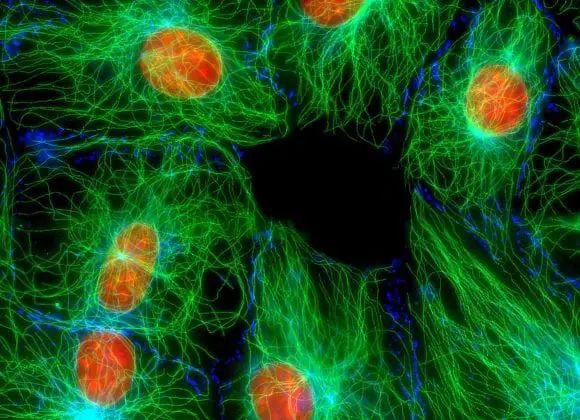Optogenetics is an emerging branch of science that uses knowledge of cell physiology, genetics and gene therapy to modulate molecular events in a targeted manner in cells. It is based on the use of proteins of certain organisms (for example some unicellular algae) that change their conformation in the presence of light by modifying the membrane action potential: these proteins, "transferred" in cells that are usually not excitable, make these cells excitable by light. Researchers use optogenetics to "turn on" or "turn off" cells with remarkable precision (single cells or regions of cells) in living animals.
As early as the 70s, many laboratories identified various trans-membrane proteins, called opsins, which reacted to light (each at a different frequency); but only in 2005 the team of K. Deisseroth, from MIT, published a revolutionary article: integrating one of these opsins, Channelrhododopsin-2 (ChR2), to those normally present in a culture of murine brain cells and stimulating it through a laser, the researchers were able to activate neurons with a temporal precision of the order of milliseconds.
In the beginning, optogenetics used ChR2 DNA, which normally allows algae to follow light, to control neuronal activity by activating a specific wavelength light. In the branch of neurophysiology, it is hoped that optogenetics "will allow in the near future to effectively treat many diseases of the brain and beyond".

Applied to ophthalmology, this technique can give important results for the treatment of retinal diseases, even family members, by reactivating retinal function, and therefore the process of vision, "inserting" the DNA of light-sensitive proteins into retinal cells that they are normally not reactive to light but can become so.
Two types of photoreceptive cells act in the eye, the cones, responsible for color vision, and the rods that guarantee night vision.
Both types of cells, once hit by the photons that make up the light, produce an electrical signal that is transmitted to the optic nerve and from this to the brain. The optogenetic technique applied to ophthalmology involves the use of an attenuated virus containing the DNA of ChR2, which, once it has entered the target retinal cells, allows them to express the protein that makes them sensitive to light and able to stimulate the phenomenon of vision, similar to how cones and rods do, the photoreceptors of the retina which unfortunately are missing in many retinal pathologies.
Researchers at the Retina Foundation of the Southwest in Dallas, Texas were the first to use optogenetics to precisely control cells. The study was based on the modification of the DNA of some cells of the retina, the glial cells, to make them react with light and send signals to the brain to remedy the loss of photoreceptors caused by retinitis pigmentosa by injecting viruses containing the DNA obtained from the algae, allowing glial cells to begin producing photosensitive proteins, transforming into cells capable of reacting to light.
The aim of the study was to produce at least 100.000 photosensitive cells, an amount sufficient to restore sufficient vision to patients.
The treatment had limitations in that the algae protein reacts only to the blue component of the light, resulting in a monochromatic vision for patients, most likely tending to black and white. A further obstacle lies in the fact that the protein does not possess the sensitivity of a wavelength of light compatible with the health of the retina.
The results obtained so far in the various fields of application of optogenetics and the commitment put into play by excellent research groups specialized in the sector scattered all over the world give us hope that the new technology will soon represent a further weapon. concrete for the fight against blindness.

